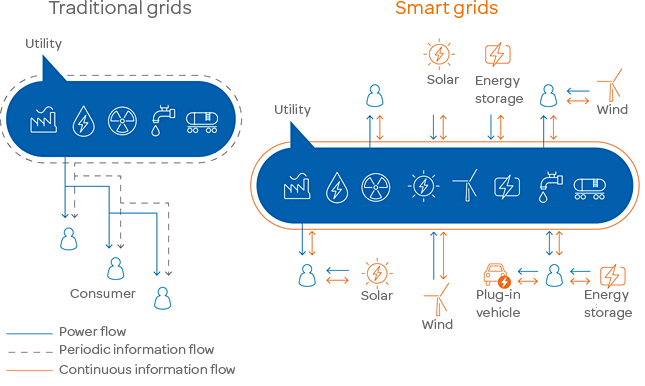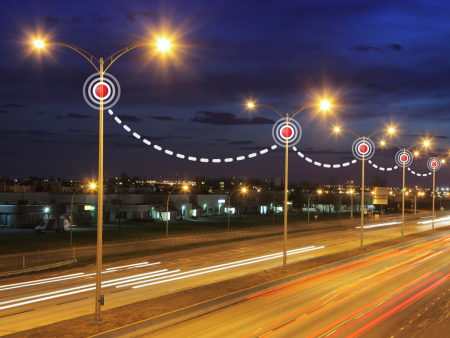Smart City of Dreams

Silver Spring Networks has taken the lead on working with cities worldwide to implement “smart” technology and make urban living more sustainable.
We live in a world where “smart” has become an inescapable prefix. The advent of the Internet of Things has showered us with choice new vocabulary, including such creative(!) words as: smartphone, smart tv, smart refrigerator, smart home, smart grid, smart meter…the list goes on. Personally, I’m becoming quite immune to the prefix, but the concept of a smart city is the stuff of dreams.
As cities continue to become increasingly populated and dense centers of life, commerce, and activity, they must adopt new technologies to manage the growing strain on their existing resources and infrastructure. One of the biggest issues to address is the growing strain on energy and its associated carbon emissions. According to The Guardian, “cities are responsible for 80% of global energy consumption” and that “by 2050, nearly 70% of the world’s population will live in cities [1].”As sensor technology and wireless infrastructure has evolved and become faster and more powerful, companies such as Silver Spring Networks have seized digitization opportunities to help cities.
Life in a Smart City
What exactly is a smart city? It might sound like something from the not-so-distant future, but we are already surrounded by elements of the smart city today. A smart city embraces innovations in technology from a variety of aspects, including:
- Transportation: driverless cars, connected vehicles
- Energy: electricity sensors, LED signage
- Water: waste management, smart water metering
IoT-focused companies generally provide solutions in three main areas: hardware (sensors and devices), software (sits in device or sensor and analyzes data, makes decisions), and infrastructure/connectivity (connects devices with each other and rest of ecosystem).
Silver Spring Networks is one such company that has been leading the charge on smart grid technology and recently extended its solutions into the smart city segment.
The Silver Bullet
Silver Spring Networks began addressing this opportunity by providing “smart grid” solutions that utilized networking technology to connect existing power grids. These solutions allowed utility companies to integrate and communicate with various devices connected to the power grid, using both hardware and software developed by SSN and others [2].

Since Michael Bell was appointed CEO in 2015, Silver Spring Networks has made a concerted effort to develop broader IoT applications for the smart city (beyond just power). The company built data platform to sit on top of its networking solutions and help customers capture and analyze the data generated by devices connected to the network, ultimately aiding in decision-making. This can get a bit abstract, so here are a few specific examples of how Silver Spring Network’s networking and data platforms together help cities run more efficiently [3]:
- “Smart Metering”
- Utilities can remotely monitor and read meters, connect and disconnect service, and detect power outages without physical inspection of the power grid
- This helps cities respond to power needs and fluctuations much more quickly and efficiently
- Demand-Side Management
- These solutions allow cities and utilities to distribute energy more efficiently and reduce usage at times of peak demand
- For example, charging electric vehicles requires significant power, and concentrated use of EV charging stations can strain the power grid. Demand management solutions help to incentivize car owners to charge during non-peak times
- Street Lights
- Street lighting is often a very significant component of city budgets, both in terms of the electricity required and the cost to repair and maintain fixtures
- Connecting these lights to a smart network can allow cities to adjust lighting levels and times much more precisely (e.g., turn off at specific times, or adjust brightness for passing pedestrians)

Nice Day for a Change
Smart city technology is still in a very early adoption phase around the world. Cities such as Paris, New York, Miami, and Singapore have implemented Silver Spring Network’s current solutions suite, but there are almost innumerable additional avenues for growth [4]. One that I find most interesting is integrating some form of weather forecasting and predictive modeling to better manage power, traffic flows, and public transportation scheduling. Weather, especially in the Northeast, has a significant impact on energy usage, commutes, and daily life. Incorporating more accurate forecasts and using existing sensors to pick-up and understand real-time weather changes could drive step-function changes in the way we move around cities and prepare for storms. For example, lights could automatically shine brighter in storm conditions, traffic lights could re-route flow away from areas prone to floods, and subway trains could increase in frequency when rain starts to pour.
Since its founding in 2002, Silver Spring Networks has bought the Internet of Things to cities around the world – I, for one, am ready to experience the smart city for myself!
Word Count: 773
Sources:
[1] https://www.theguardian.com/sustainable-business/blog/smart-cities-energy-consumption
[2] http://www.silverspringnet.com/
[3] https://www.sec.gov/Archives/edgar/data/1180079/000156459016014307/ssni-10k_20151231.htm
[4] https://www.greenbiz.com/blog/2013/07/29/how-silver-spring-networks-saw-light-led-lit-cities



Smart cities are something to be excited about, but I wonder: to what extent can they be implemented? It’s difficult enough to invest in greenfield smart city projects, but retrofitting existing cities to equip them with IoT capabilities sounds painful and costly.
You can always argue that smart cities pay for themselves over the long run through efficiency gains but government entities are risk-averse and, for the most part, short-term focused. They may not have the appetite for such a risky play.
For now, governments will likely limit their investments to ‘quick wins’ like smart lights which offer direct savings on energy consumption. Benefits from digitizing waste management and water systems are less obvious and harder to quantify so those enhancements will probably come later. We’re probably a long way from highly interconnected digital cities anticipating and optimizing for people’s mobility needs.
It is indeed exciting to see all the progress being made toward smarter cities, but as JM points out, the business model behind these technologies is not always clear. As the technologies prove their potential to create efficiencies and savings, though, governments will likely become more comfortable with the investments, and others will be willing to finance projects with clearly understood returns.
Another concern about smart city technologies—particularly in regards to utilities—is the potential for security breaches. A few weeks ago, several major websites were shut down as the result of a DDOS attack mounted from Internet of things devices. With many individual devices containing few or no security protocols, we are creating a substantial risk. It is not unlikely that we will see more direct attacks on infrastructure using smart cities technology—when your city’s power, lights, and water supply are all connected to the Internet, you do run the risk of losing all three at once. While I’m excited about the opportunities that these technologies create, being careful about security is key toward long-term success and cities’ willingness to adopt the systems.
Great post! The idea of a smart city is very interesting. This article seems to suggest that we are wasting energy just because we do not have full information about how we are using available energy sources. It is great to see that Silver Spring is tackling the problem from two angles – 1) energy source and 2) energy usage. I normally think about energy conservation as being driven by #1 and changing the types of energy we use. Silver Spring seems to be tackling the whole picture starting with energy usage which is a fascinating approach to the challenge.
An excellent post, succinct yet meaningful. Smart cities are a way of the future and as a tech enthusiast, I am very excited about them. In fact, smart cities is a massive pet project of the Indian government which it launched last year with plans to invest $15billion to initially convert 100 Indian cities to smart cities. While smart cities sound amazing, making them is a herculean task. Which is why it is always an incremental project – starting with the most basic services and then moving on to the more advanced resources. However a rising use of non-renewable energy and resources by a majority of the worlds countries presents a direct conflict to the usage and purpose of a smart city that is built to run on environmentally friendly resources.
Thanks for the great post! I’m really excited about the potential for demand-side management – it’s really important in decreasing total energy usage but also in reducing the carbon intensity of our energy usage. Typically, power systems are connected to a broad array of power plants. The lowest cost resources run almost constantly, but there are some more expensive forms of power generation that are only run in the highest demand hours when wholesale electricity prices are really high. These resources are typically very carbon intensive (inefficient gas/petroleum plants) – if consumers are able to shift that peak demand to off-peak hours, we can avoid switching on these carbon-intensive plants and decrease the carbon intensity of our energy. The problem is that wholesale power prices that reflect demand in each unit of time are not transparent to the end consumers so individuals don’t have the price signals they need to shift demand. If electricity providers implement dynamic pricing for consumers, SSN will be even better positioned to make cities smarter and greener. For an example of the dispatch curve of a typical power system, click here: http://www.eia.gov/todayinenergy/detail.php?id=7590.
Interesting read. It seems to me that Silver Spring Networks (along with a select few competitors) is in a strong position to be able to offer a full suite of “smart city” energy efficiency and management solutions. This is certainly something that municipalities will need, as they likely do not have the ability to manage different suppliers and likely software systems for each potential upgrade. One challenge that I foresee is communicating the value proposition accordingly and getting municipalities to sign on to a full suite of products. My husband spent the past two years selling distributed generation solar projects to municipalities. In this instance the value proposition was clear, but the sales cycle extremely slow and cumbersome, as there were constantly a large number of stakeholders to be convinced. I’d imagine this to be even more true for more complex offerings like demand-side management products. I’d be interested in knowing how SSN approaches their sales process.